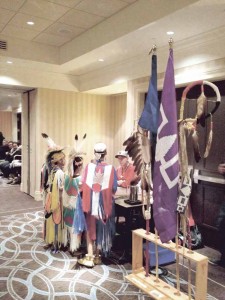“We were once a very strong, powerful and loving people,” said Chisasibi healer Harry Snowboy. “We need to get that spirit back. I saw a glimpse of it in the old people I grew up around – how strong we are. It’s not something that is lost. It’s only something that needs to be reawakened. As long as we have our ancestors, nothing is lost.”
Snowboy was speaking at the 13th annual Dialogue for Life conference on Indigenous suicide prevention, which ran November 21-23 in Montreal. Hosted by the First Nations and Inuit Suicide Prevention Association of Quebec and Labrador, it offered a space for frontline workers, families and individuals to receive both healing and training in dealing with losing loved ones to suicide, seeing others contemplate killing themselves, and having such feelings oneself.
Organizer Chad Diabo explained that the conference began simply as a place for frontline workers dealing with Native suicide.
“When you’re talking about training frontline workers, one of the realities in Native communities is that our frontline workers are always on call. They may get paid for a 9-to-5 shift, but once they go home, people know where they live.”
That means a frontline worker can’t take a break from their duties, even out on their trap lines or fishing on the open water, because suicide remains a threat lurking in their communities.
“There’s always people going into crisis,” Diabo said. “The worker dealing with suicide is always on call, always bombarded, 24-7. Firefighters get a break. Police officers get a break. Frontline workers don’t. It’s their weekends, their evenings, their son’s birthday party. When a crisis comes in, they’ve got to go deal with someone who wants to kill themselves.”
Dialogue for Life began in Montreal as a way to bring those workers far away enough from their communities so that they couldn’t be called away, but it has grown from offering training and healing to suicide-prevention workers to welcoming a variety of Elders, students and other individuals.
“Entire families come to the Dialogue for Life,” said Diabo. “Kids are working on kids’ issues, Elders are working on Elders’ issues, multi-generational trauma, issues with stuff that happened in residential schools and Indian day schools. Everybody gets to work on their stuff, either collectively or by seeing people one-on-one.”
The conference offers a variety of approaches, including from western professional trainers, natural healers and traditional teachers from different First Nations. The atmosphere is warm and friendly – there are feasts and a powwow on opening night. Throughout the conference there is a feeling of open-hearted support.
“One of the realities is that suicide is taboo, but we need to start talking about it,” Diabo explained. “If we don’t talk about it, it remains the monster underneath the bed. What’s good is when you take a flashlight and aim it underneath the bed, there’s nothing there. That’s not to say that suicide is nothing, but the monster gets really small when you flash the light on it. What we’re doing is trying to work to make that monster even smaller.”
Diabo says one of the great successes of the conference is that it brings together people from many perspectives, including different Indigenous Nations, to see how others are handling the issue of suicide. Mohawks can see how Inuit are dealing with it, and Cree and Innu can see what Mi’kmaqs are doing.
“We can learn from one another without recreating the wheel,” Diabo said. “If it works to stop one person from taking their life, you’re learning something.”
Many people at the conference were talking about Snowboy. The phrase “He’s really good” was widely repeated. He offered healing counselling sessions that were booked solid for the length of the conference.
“Healing work has been in my family for generations,” he said, “on both sides of my mother’s (Rupert) and father’s families. I grew up in that. In the 1960s and early 1970s, we were still a very isolated people. I grew up on the land – I went to school, but I spent a lot of time with my grandparents, my mother’s mother. She knew a lot about the plants and spirituality.”
Snowboy says his counselling involves a combination of culture and spirituality. He notes that in the past, Indigenous people across many nations found identity in rites of passage as adolescents, which taught them to understand themselves.
“How can you love yourself when you don’t know your identity?” he asked. “You have to learn who you are in order to know what you’re going to love.”
While Snowboy believes that land-based healing is valuable, he noted that even for those Nations that don’t have access to much land, the healing that comes from ancestry lives on.
“A lot of it has to do with spirituality. I believe as people, who we are is 80% spiritual. That 20% is traditional skills. So if you can find that 80%, you’ll be able to feel that anywhere. That’s what I tell them. I can’t come in between them and God. They have to find that within themselves. They can go anywhere and still feel that part of what they have left.”

